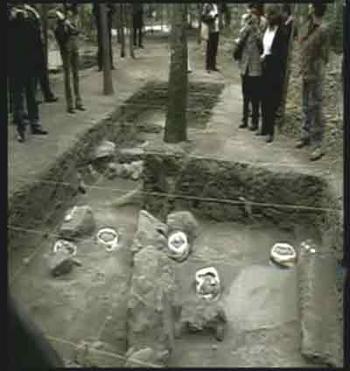Archaeologists discovered ancient city of Aztecs
 Archaeologists unearthed remains of Aztec's ancient capital in Mexican suburbs.
Archaeologists unearthed remains of Aztec's ancient capital in Mexican suburbs.
Scientists claim that the find will shed the light onto the history of mysterious civilization of the pre-Columbian America.
Chapultepec castle constructed in XVIII century as a residence of viceroys of New Spain, represents a kind of a tomb stone of the Aztec's civilization. Stone basements of the fort hide ruins of the ancient Teotihuacan. This has been concluded by a team of Mexican archaeologists who had been excavating the massive city for the past six years. They were able to discover fragments of ceramics, figurines of deities and even needles made of bones used for needlework.
“We managed to excavate a rather significant amount of fragments of the so-called classical period as well as those belonging to the colonial epoch,” stated archaeologist Rosio Morales. “Judging by the finds, members of the Indian elite had lived in the region.”
Teotihuacan, which literally means “a place where Gods are born,” still conceals many mysteries. Neither the exact date of the construction, nor the reasons for the city’s abandonment are known. The settlement has been divided into several sectors. The Avenue of the Dead, the main street of Teotihuacan divides the city into two sections. The Sun Pyramid as well as The Moon Pyramid remains well-preserved.
Remains of ancient cities have been excavated within approximately fifty kilometers of modern Mexico. Nowadays however it has been decided that the actual capital of the ancient empire had been vaster than commonly considered.
This is the first time that excavations take place right in the middle of the Chapultatac park with its museums, restaurants and botanic gardens. This constitutes an important scientific discovery as well as new bait for tourists. Mexico has once again proven to be a live museum of history of civilizations.
Aztec culture represents the last link in a long chain of developed civilizations in pre-Columbian Mesoamerica. Olmec culture was the oldest of all. It developed on the shoreline of the Mexican bay in 14-3 century BC. It was them who prepared the grounds for developing civilizations. That is why their epoch is called pre-classical. Olmecs possessed highly developed mythology, constructed spacious pantheons and were exceptionally skilled stone engravers and potters. Their society differed from the rest with its hierarchal structure and narrow professional orientation. The latter referred to the fact that religious, leading and maintenance roles were conducted by specially trained individuals. Such distinct characteristics of Olmecs were later adopted by other cultures.
Source: Vesti.Ru, Ancient World.
Subscribe to Pravda.Ru Telegram channel, Facebook, RSS!





